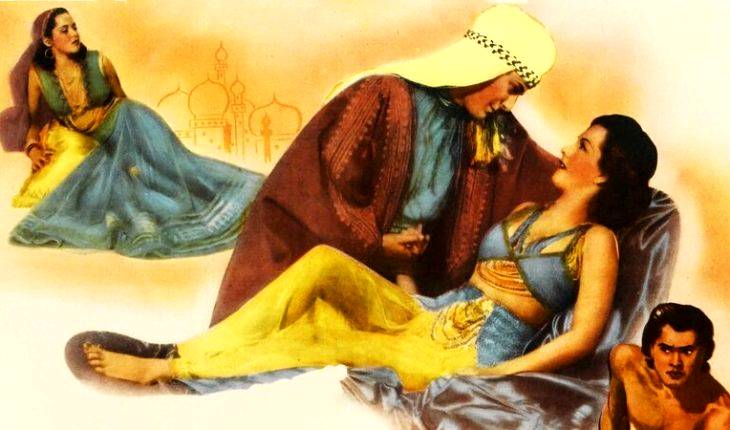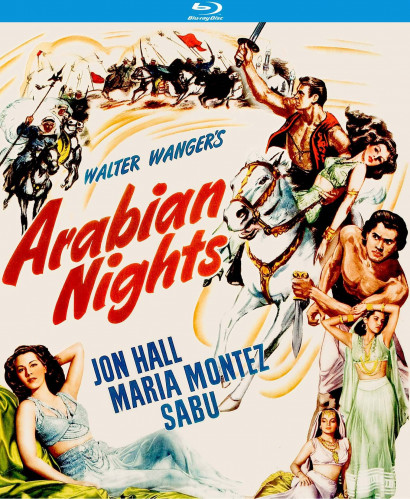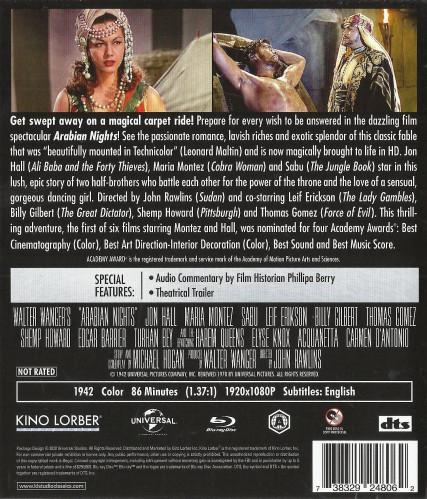ARABIAN NIGHTS [1942 / 2020] [Blu-ray] [USA Release] All The Thrills . . . All The Romance . . . Of 1001 Nights in Glorious Technicolor!
Get swept away on a magical carpet ride! Prepare for every wish to be answered in the dazzling film spectacular ‘ARABIAN NIGHTS.’ See the passionate romance, lavish riches and exotic splendour of this classic fable that was “beautifully mounted in Technicolor” [quote by Leonard Maltin] and is now magically brought to life in High Definition. Jon Hall [‘Ali Baba and the Forty Thieves’], Maria Montez [‘Cobra Woman’] and Sabu [‘The Jungle Book’] star in this lush, epic story of two half-brothers who battle each other for the power of the throne and the love of a sensual, gorgeous dancing girl. Directed by John Rawlins [‘Sudan’] and co-starring Leif Erickson [‘The Lady Gambles’], Billy Gilbert [‘The Great Dictator’], Shemp Howard [‘Pittsburgh’] and Thomas Gomez [‘Force of Evil’]. This thrilling adventure, the first of six films starring Maria Montez and Jon Hall, was nominated for four Academy Awards: Best Cinematography [Technicolor], Best Art Direction-Interior Decoration [Technicolor], Best Sound and Best Music Score.
FILM FACT No.1: Awards and Nominations: 1943 Academy Awards®: Nominated: Best Cinematography, Technicolor for Milton R. Krasner, William V. Skall and W. Howard Greene. Nominated: Best Art Direction-Interior Decoration, Technicolor for Alexander Golitzen, Jack Otterson, Russell A. Gausman and Ira Webb. Nominated: Best Sound Recording for Bernard B. Brown. Nominated: Best Music, Scoring of a Dramatic or Comedy Picture for Best Music, Scoring of a Dramatic or Comedy Picture.
FILM FACT No.2: Walter Wanger had just joined Universal Pictures for whom he had made ‘Eagle Squadron.’ Looking for a follow up he noted the box office success of ‘The Thief of Bagdad’ which starred Sabu, who was under contract to Universal Pictures. The studio announced they would make the film on 24th March, 1942. Maria Montez, Jon Hall and Sabu were always meant to star. John Rawlins was assigned to direct and filming started in June 1942. Even before filming began Universal Pictures announced the trio of leads would appear in a follow up ‘Cobra Woman.’ Shortly after that the studio said they would appear in another film ‘White Savage.’ The film was the first shot in Technicolor on the Universal Pictures lot in 12 years. Parts of the film were shot in the Coral Pink Sand Dunes State Park in Utah.
Cast: Jon Hall, Maria Montez, Sabu, Leif Erickson, Billy Gilbert, Edgar Barrier, Richard Lane, Turhan Bey, John Qualen, Shemp Howard, William “Wee Willie” Davis, Thomas Gomez, Jeni Le Gon, Robert Greig, Charles Coleman, Adia Kuznetzoff, Emory Parnell, Harry Cording, Robin Raymond, Carmen D'Antonio, Acquanetta (uncredited), Carlos Alvarado (uncredited), Daniel Barone (uncredited), Robert Barron (uncredited), John Berkes (uncredited), Anthony Blair (uncredited), Linda Brent (uncredited), Lane Chandler (uncredited), André Charlot (uncredited), Ken Christy (uncredited), Paul Clayton (uncredited), Rosemary Dempsey (uncredited), June Ealey (uncredited), Virginia Engels (uncredited), Phyllis Forbes (uncredited), Frances Gladwin (uncredited), Amador Gutierrez (uncredited), Eloise Hardt (uncredited), Al Haskell (uncredited), Jamiel Hasson (uncredited), Cordell Hickman (uncredited), Elyse Knox (uncredited), Frank Lackteen (uncredited), Patsy Mace (uncredited), Murdock MacQuarrie (uncredited), Edward Marmolejo (uncredited), Kermit Maynard (uncredited), Kathleen McCormack (uncredited), Art Miles (uncredited), Mary Moore (uncredited), Alice Neilson (uncredited), Veronica Pataky (uncredited), Helen Pender (uncredited), Eva Puig (uncredited), Rebel Randall (uncredited), Suzanne Ridgway (uncredited), Nedra Sanders (uncredited), Peggy Satterlee (uncredited), Mickey Simpson (uncredited), Pat Starling (uncredited), Amzie Strickland (uncredited), Nick Thompson (uncredited), Jean Trent (uncredited), Ben Ayassa Wadrassi (uncredited), Crane Whitley (uncredited), Ernest Whitman (uncredited) and Duke York (uncredited)
Director: John Rawlins
Producer: Walter Wanger
Screenplay: Michael Hogan (story/screenplay) and True Boardman (additional dialogue)
Composer: Frank Skinner
Costume Design: Vera West (Women’s Costumes)
Cinematography: Milton R. Krasner, A.S.C. (Director of Photography)
Technicolor Color Director: Natalie Kalmus
Image Resolution: 1080p (Technicolor)
Aspect Ratio: 1.37:1
Audio: English: 2.0 DTS-HD Master Audio
English: 2.0 Dolby Digital Stereo Audio
Subtitles: English
Running Time: 86 minutes
Region: Region A/1
Number of discs: 1
Studio: Universal Pictures / Kino Lorber Studio Classics
Andrew’s Blu-ray Review: ‘ARABIAN NIGHTS’ [1942] is a glorious adventure film featuring Sabu, Jon Hall and María Montez who would later star together again in the film ‘Cobra Woman.’ ‘ARABIAN NIGHTS’ is the first of six similar films which paired Jon Hall and Maria Montez. This picture is noted for being the first film Universal Pictures used the three-strip Technicolor film process.
‘ARABIAN NIGHTS’ was the first screen teaming of Jon Hall and Maria Montez as she plays the enchanting Scheherazade and the Haroun Al-Raschid the legendary medieval Caliph of Bagdad. Jon Hall is in a bind, he's the victim of a palace coup involving half-brother Leif Erickson and the Wazir Edgar Barrier.
In ‘ARABIAN NIGHTS’ we find Haroun-Al-Raschid [Jon Hall], and his half-brother Kamar [Leif Erickson], battle each other for the power of the throne in Baghdad and the love of a sensual, gorgeous dancing girl, Sherazade [Maria Montez], who is part of a circus act owned by Ahmad [Billy Gilbert]. At first Sherazade does admit that she would rather have power than love but as the film progresses, she has a change of heart. In addition to Sherazade, the circus includes Sinbad the Sailor [Shemp Howard] and Aladdin [John Qualan]. Because Haroun-Al-Raschid was attacked by Kamar and his followers for which he was outnumbered, forcing him to run and hide. While hiding away from Kamar’s forces he is discovered by a free-spirited acrobat Ali Ben Ali [Sabu]. Haroun-Al-Raschid, Ali Ben Ali, and Ahmad join forces to stop Kamar from his reign of terror over Baghdad and also to win the heart of Sherzade.
‘ARABIAN NIGHTS’ is also noteworthy in the career of co-star, Jon Hall – the broad-shouldered hunk du jour who had dazzled audiences with his raw and muscular sex appeal. Like Sabu, Jon Hall’s presence in the films squarely rested on his physical appeal – in Jon Hall’s case, that of the hunky slab of beefcake whose barrel-chest and rippling arms could barely be contained in his costumes.
John Hall was born in Fresno, California, but raised by a Swiss father in Tahiti; and John Hall received a formal education in preparation for a career in diplomatic service. Alas, it was not to be; John Hall, bitten by the acting bug, trying his hand at the movies, first, using his real name – Charles Locher – for Monogram Pictures, then, as a contract player at 20th Century-Fox. Unsuccessful, John Hall became a freelancer, changing his professional name to Lloyd Crane, and finally, to his film star name Jon Hall.
‘ARABIAN NIGHTS’ is a wonderful fantasy film that has a lot of action throughout. I decided to watch it a couple of times in the past week because it was that entertaining. I was amazed how much I enjoyed this fantasy film; it is a really fun adventure ride from start to finish. The film has a great cast, in addition to the three leads Jon Hall, Sabu and Montez, the film also has several name actors including Turhan Bey and Shemp Howard. We also have Thomas Gomez and William ‘Wee Willie’ Davis is also part of the superb veteran cast, and the legendary comedic actor Billy Gilbert.
For those not familiar with Billy Gilbert, he was an actor and comedian who appeared in over 200 films including several Laurel and Hardy classic short films. Among them are ‘The Music Box,’ ‘The Chimp,’ ‘Block-Heads’ and ‘County Hospital.’ Other choice films under his resume include ‘Snow White and the Seven Dwarfs,’ ‘One Hundred Men and A Girl,’ ‘Destry Rides Again’ and ‘His Girl Friday.’
Howard Greene, Milton R. Krasne and William V. Skall were the men responsible for the wonderful cinematography in the film, capturing some gorgeous scenery. Frank Skinner provided the outstanding triumphant soundtrack for this classic which will keep you on the edge of your seat.
‘ARABIAN NIGHTS’ is one of the best early Technicolor efforts out of Hollywood and it really shows. It is great fun with a little something for everyone. The Blu-ray is an excellent transfer and it is a simple action film with good caliphs and bad caliphs. There's the gorgeous Maria Montez and the costuming will simply amaze you. This film can be watched by everyone except small children as it has a couple of killings – non graphic and 1 torture scene – also non graphic, but despite this it is a really good film fantasy to enjoy. It is still a sumptuous looking film for the eye and the action keeps moving. If your taste runs to fantasy of this kind ‘ARABIAN NIGHTS’ is your type of film fantasy!
* * * * *
Blu-ray Image Quality – Universal Pictures and Kino Lorber Studio Classics presents us the film ‘ARABIAN NIGHTS’ in the original 1.37:1 full frame aspect ratio. This is an altogether outstanding 1080p presentation with little in the way of print damage, scratches, and other imperfections. The Technicolor imagery looks totally impressive and this is an engaging, beautiful film. The scan looks naturally filmic and is keeping with the intended aesthetic of the film. The fine layer of film grain is well preserved and is quite impressive.
Blu-ray Audio Quality – Universal Pictures and Kino Lorber Studio Classics brings us the film ‘ARABIAN NIGHTS’ with just one standard 2.0 DTS-HD Master Audio experience. This is a surprisingly robust and pleasurable listen. The audio track has excellent clarity and detail given the age of the source elements. There were no distracting instances of egregious hiss, crackle, pops, warps, and other unwelcome audio elements which can result from a poor quality master. Instead, the track on the release is crisp, clear, and easy to understand. Dialogue is well reproduced and the track never sounds overly tight or muffled.
* * * * *
Blu-ray Special Features and Extras:
Audio Commentary by Film Historian Phillipa Berry: As the credits appear for the film ‘ARABIAN NIGHTS’ starts Phillipa Berry introduces herself and informs us that she has 1001 tales to tell about Walter Wagner’s ‘ARABIAN NIGHTS’ which was released in 1942 by Universal Studios, so pull up a cushion and Phillipa Berry will begin. Phillipa Berry also informs us that the wonderful exotic little graphics and with the reworked Universal Pictures logo create an exotic look atmosphere and also setting the scene is Frank Skinner’s dramatic swirling score, which evokes the exotic East. Frank Skinner had already written atmospheric scores for several other Universal Pictures fantasy films and including ‘Son of Frankenstein’ [1939], ‘The Invisible Man Returns’ [1940] and a couple of Sherlock Holmes series. The ‘ARABIAN NIGHTS’ composed film score was used five years later for the Universal Pictures film ‘Baghdad’ [1949]. And Phillipa Berry now informs us that our story begins in a similar style to the original “Arabian Nights” book that is a story within a story and the core of the story is about the tales told by the sultana Scheherazade, who relates them as entertainment for her jealous and murderous husband the vengeful King Shahryar who was incensed by his first wife’s adultery and sets about beheading all of his subsequent virgin brides after deflowering them, so Scheherazade is spared because she tells over a thousand and one nights stories to delay her execution of her life. At this point we get the start of the actual ‘ARABIAN NIGHTS’ film where we get to meet the two brothers of great rivalry of hatred for each other, and we meet Haroun-Al-Raschid [Jon Hall], and his half-brother Kamar [Leif Erickson], who tied up waiting for the vultures to devour him as he is near on dead, but when he is cut down, we suddenly get the rivalry between the two brother proclaiming to be the rightful ruler of the kingdom and the empire. Eventually we get to meet the beauty of Maria Montez as Scheherazade who is very head strong and Phillipa Berry gives us a brief history lesson about the actress Maria Montez who was born María África Gracia Vidal (6th June, 1912 – 7th September 1951), and was a Dominican motion picture actress who gained fame and popularity in the 1940’s starring in a series of filmed-in-Technicolor costume adventure films. Maria Montez’s screen image was that of a seductress, dressed in fanciful costumes and sparkling jewels. Maria Montez became so identified with these adventure epics that she became known as The Queen of Technicolor. Over her career, Maria Montez appeared in 26 films, 21 of which were made in North America, with the last five being made in Europe. Unfortunately on the 7th September, 1951 Maria Montez was discovered drowned in her bath, possibly having first suffered a heart attack. But as to the actress Maria Montez and her career, it was well known that the camera really loved her and especially for amazing beauty, and embodied total glamour that you do not see in modern films. Eventually, at this point in the film we get the first entrance of Sabu with the acrobatic scene and we are informed that Sabu was born in 1924 in Karapur, Mysore, Kingdom of Mysore, and then a Princely State of British India. Sabu was the son of an Indian mahout “Elephant Rider.” When Sabu was 13, was discovered by documentary filmmaker Robert Flaherty, who cast him in the role of an elephant driver in the 1937 British film ‘Elephant Boy.’ In 1938 producer Alexander Korda commissioned A. E. W. Mason to write The Drum as a starring vehicle for the young actor. Sabu is perhaps best known for his role as Abu in the 1940 fantasy adventure film The ‘Thief of Bagdad.’ Director Michael Powell said that Sabu had a “wonderful grace” about him. In 1942, Sabu played another role based on a Rudyard Kipling story, namely Mowgli in Rudyard Kipling's “Jungle” Book directed by Zoltan Korda, which was shot entirely in California. Sabu starred alongside Maria Montez and Jon Hall in three films for Universal Pictures: ‘Arabian Nights’ [1942], ‘White Savage’ [1943] and ‘Cobra Woman’ [1944]. Sabu also appeared in ‘Black Narcissus’ [1947] and ‘The End of the River’ [1947]. After this, Sabu left Great Britain for good and spent the rest of his career making relatively undistinguished Hollywood films and building a successful career in property. Sadly Sabu died of a heart attack at a shockingly young 39 years of age shortly after completing his first Disney film ‘A Tiger Walks’ [1963], and was buried in Hollywood's famous Forest Lawn cemetery. Because of war restrictions, Universal Pictures ‘ARABIAN NIGHTS’ had a very limited budget, and special effects were kept to a minimum, but were very effective and was the first to use the three strip Technicolor process so they wanted all of the spectacle scenes to give the public all the money they could buy. When we see the blind beggar, we are informed that he was the actor John Berkes who was uncredited in ‘ARABIAN NIGHTS’ and in the 1930’s he appeared in a lot of films and in 1951 hear appeared with Kirk Douglas as the trapped miner in the Billy Wilder film ‘Ace In The Hole’ and sadly died in the year that the film was released. Universal Pictures fans will probably recognise the torture chamber that appeared in film like ‘Green Hell’ [1940], through several Mummy films, as well as Abbott and Costello films, and especially the ‘Phantom Of The Opera’ [1943] and ‘Cobra Woman’ [1944]. When we get to the scene where the escaped prisoners arrive at the coast and get their chains removed, they are actually at the location of the Malibu Creek State Park, just 25 miles from downtown Los Angeles, and has a long and proud history of Hollywood productions that began with the black and white silent films ‘Daddy Long Legs’ [1919] starring Mary Pickford, ‘Annie Laurie’ [1927] with Lillian Gish and then on into the sound era with ‘Tarzan Escapes’ [1936] starring Johnny Weissmuller and Maureen O'Sullivan and ‘Blockade’ [1938] with Henry Fonda. The location was also used with the Walter Wagner Spanish Civil War film ‘Blockade’ [1938]. Phillipa Berry again talk about the actress Maria Montez and in the mid-1960’s there was one of her greatest fan of this actress and he was Jack Smith (14th November, 1932 – 18th September, 1989) was an American filmmaker, actor, and pioneer of underground cinema. Jack Smith is generally acclaimed as a founding father of American performance art, and has been critically recognized as a master photographer, though his photographic works are rare and remain largely unknown. Jack Smith was no fan of Yvonne De Carlo, considering her a second-rate Maria Montez. Jack Smith wrote a piece about the actress Maria Montez entitled “The Perfect Filmic Appositeness of Maria Montez” in which Jack Smith said, “She was not an actress who gave performances as such.” Jack Smith saw this as limiting, and called out critics who said, “Were hostile and uneasy in the presence of visual phenomenon,” and talked about Maria Montez appeal as being on a purely inclusive level and that it transcends technique.” Jack Smith revelled in Maria Montez films, in saying, “Glamourous rapture, Schizophrenic delight, Hopeless naivety and glittering Technicolor brash, creating a one woman’s belief, not an actress.” Whether you agree or not agree with Jack Smith, and his extreme appreciation of Maria Montez, his point is simply is that it is not about the performance of the presence of the star herself. Quentin Crisp made a scathing attack on Hollywood and the star system that was mentioned in his book entitled “How to go to the movies.” Since moving to New York City over a decade ago, Quentin Crisp has brought his love of the cinema and his notorious wit together in a series of essays on films and film stars. A veteran film-goer of seventy years who has kept a vigilant eye on changing Hollywood styles and the public tastes that follow, Mr. Quentin Crisp discusses both films and stars with his typical panache and dexterity and leads his readers with polite madness to a clear, straightforward moral, proving himself to be an unexpected champion of good sense. Along the way Mr. Quentin Crisp shares his personal encounters with the likes of Lillian Gish, John Hurt, David Hockney, Divine, Sting, and Geraldine Page. Prefaced by longer essays on the essence of stardom, the nature of Hollywood and the deplorable state of that town today, Mr. Quentin Crisp's book is a delight to read. In Mr. Quentin Crisp’s book makes a lot of scathing attack on Hollywood and the star system, and Mr. Quentin Crisp laments by saying, “The collapse of stardom, and blames audiences for their failure to record the lofty status of actors as they once did and complained that levelling of social status, has removed the glamour and the mysterious otherness they once had.” Mr. Quentin Crisp also says, “That all Hollywood stars remain essentially themselves in ever decreasing roles, with only variations of circumstances and costumes for each movie, this side steps the whole notion of acting with realistic effect, reality is irrelevant, the star remains the focus irrespective of the character they played.” When we get to chapter 7 at precisely 1:07:20, Phillipa Berry says, “And here we are back at the blacksmith with Harry Cording with another long scene for belly laughs, and now we get to see that Walter Wagner hired True Boardman for additional dialogue for the film, and True Boardman had previously written dialogue for Abbott and Costello and double comedy scene we get to see with John Qualen and the comedy dialogue we get to hear could easily come from the mouths of Abbott and Costello and the straight man in that scene was Richard Lane, who we saw earlier in the film outside the tent of the Harem. Then we get to see the now clean shaven actor Billy Gilbert as the “Bag of Baghdad” and probably one of the worst female impersonator ever committed to film, but I guess the enlivens the humorous part of the scene. As we get near to the end of the film, Phillipa Berry says, “Well that my friends is just one of 1001 nights and I hope you enjoyed seeing it restored to its full Technicolor glory, I bid you a safe journey where ever your caravan should take you.”
Theatrical Trailer [1942] [1080i] [1.37:1] [2:07] This is the Original Theatrical Trailer for the film ‘ARABIAN NIGHTS.’
Theatrical Trailer [1944] [480i] [1.37:1] [2:16] This is the Original Theatrical Trailer for the film ‘Ali Baba and the Forty Thieves.’
Theatrical Trailer [1944] [1080i] [1.37:1] [2:08] This is the Original Theatrical Trailer for the film ‘Cobra Woman.’
Theatrical Trailer [1952] [1080i] [1.37:1] [2:03] This is the Original Theatrical Trailer for the film ‘Son of Ali Baba.’
Finally, ‘ARABIAN NIGHTS’ is a thrilling adventure that has enough charm and spectacle to keep things engaging for audiences who have become accustomed to CGI-laden blockbusters. ‘ARABIAN NIGHTS’ is every bit as entertaining as ‘The Thief of Bagdad’ also with Sabu and is great escapism which we all sorely need right now! Though some might feel the film is too dated in some respects, the action and spectacle remains a really worthwhile experience. The Blu-ray release is top-notch and features a superb presentation. Highly Recommended!
Andrew C. Miller – Your Ultimate No.1 Film Aficionado
Le Cinema Paradiso
United Kingdom



